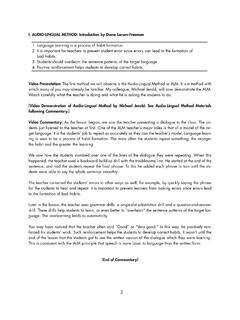Transcription of From Theory to Practice for Teachers of English Learners - ed
1 18 The CATESOL Journal 2010/2011 From Theory to Practice for Teachersof English LearnersTeaching and learning English in the US are complex processes that are not explained by language theories or methods alone. Concepts such as the relationship between language majority groups and lan-guage minority groups, language status, immigration, economics, language planning, and policies add to the complexity of language-learning situations. Effective Teachers for the more than 5 million English Learners (ELs) in kindergarten through 12th grades require unique knowledge, skills, and dispositions. This article provides a review of the language, learning, and language learning theories and practices for second language teaching, focusing on sociocul-tural theories and article provides an overview of theories, approaches, and practices in teaching children who speak languages other than English in K-12 schools in the US.
2 Building from a synthesis of the literature on teaching English as a second language, I conclude by noting the pedagogical knowledge and skills Teachers in K-12 settings must have to appropriately meet the needs of this growing population. An additive and culturally responsive approach is taken in addressing the educational needs of English Learners (ELs), namely that using children s languages and cultural backgrounds should be viewed as resources in helping them succeed academically (Kloss, 1998).The education of the nation s more than 5 million English Learners (Goldberg, 2008) depends on the delivery of academically rigorous and lin-guistically appropriate instruction by their Teachers .
3 While the need to provide this type of instruction for all English Learners is critical, it is imperative for English Learners at the K-12 level. K-12 English Learners have the dual urgency to acquire English proficiency while simultaneously mastering the increasingly complex requirements for high school graduation. As such, it limits the review of instructional practices to those that have been most influential in the devel-opment of second language teaching as it is practiced review includes a synthesis of the history of second language teaching with a focus on the relationships between language learning and language teach-ing. Language teaching methods, along with the learning theories that guide those methods, will help inform the recommendations for effective beginning MAGALY LAVADENZL oyola Marymount UniversityThe CATESOL Journal 2010/2011 19 English as a Second Language instruction at the K-12 level.
4 Perspectives on the impact of reforms such as the role of standards and technology for English Learners will also be included. The requisite teacher expertise for the appropri-ate instruction of K-12 English Learners at the beginning levels of English pro-ficiency across the language skills (listening, speaking, reading, and writing) is also highlighted. Second Language Teaching:Perspectives on Learning and Language TheoriesThe historical antecedents of contemporary language teaching methods are premised upon notions about human learning. Language teaching is in-fluenced by the fields of linguistics and psychology and, by extension, second language teaching methods are closely related to concepts and theories about the ways in which humans learn in general, along with the ways in which lin-guists define language.
5 The following sections briefly review theories of learn-ing, followed by theories of language, and their relationship to second language teaching. Learning Theories and Second Language TeachingLearning theories can best be described as conceptual or philosophical ori-entations about ways that human beings learn. These include behaviorist, cog-nitive, and sociocultural perspectives (see Table 1). Behavioral learning Theory views learning as a response to stimuli in the environment; the learner is a creature of habit who can be manipulated, observed, and described (Brown, 1994; Gass & Selinker, 1994; Skinner, 1957). Behaviorist influences in second language teaching can be observed in methods such as the audio - lingual ap-proach and situational language teaching (described later in this article).
6 Table 1 Overview of Learning Theories and Teaching ImplicationsLearning theoryOriginationDefinitions and instructional implicationsBehavioristUS c. 1914; influenced by European empiricism Learning as a response to environmental stimuli and can be manipulated, observed, and described (Watson; 1919, Skinner, 1938). Teaching thus is through Practice , repetition, and rewards. Cognitive1950s to presentLearning can be explained as deep, complex psychological phenomena such as motivation, schemas, and processes for learning (Bruner, 1996; Piaget, 1974). Teaching occurs in phases with gradual to presentLearning is influenced by social, cultural, and historical factors. Learning takes place within social interactions (Vygotsky, 1978; Wertsch, 1991).
7 Teaching occurs through meaningful interactions between experts and The CATESOL Journal 2010/2011 Cognitive learning theories attempt to explain deeper, complex psycholog-ical phenomena such as motivation, schemas, and other processes for learning. This orientation can be described as comprising two branches, developmental cognitive learning, from the work of Piaget (1974), and socio-constructivist, based on the work of Vygotsky (1978) and Bruner (1996). Developmental ap-proaches propose that learning occurs in stages and follows a sequence, where-as socio-constructivist approaches propose that development occurs because of learning and because it is scaffolded (Bruner, 1996)
8 Or supported through interaction of some views of learning, which build upon constructivist approach-es, are often linked together in the psychological and pedagogic literature, and they include the premise that second language teaching and learning take place within the social interactions of Learners and more capable others and seek to understand the cultural and historical influences on learning (Faltis & Hudelson, 1998; Lave & Wenger, 1991; Wertsch, 1991). A sociocultural Theory of learning begins with assumption that action is mediated and that it cannot be separated from the social milieu in which it is carried out (Wertsch, 1991, p.)
9 18). Table 2 summarizes the basic tenets of sociocultural 2 Tenets of Sociocultural Theory Learning precedes development. Language is the main vehicle (tool) of thought. Mediation is a central concept of learning. Social interaction is the basis of learning and development. Internalization is a process that transforms learning from the social to the cognitive (individual) plane. The Zone of Proximal Development is the primary activity space in which learning takes language educators must be knowledgeable about the development of learning theories both in terms of their historical development and in terms of their analogous relationship to language teaching.
10 The next section reviews theories about language that will be briefly defined in order to apply them later in the review of second language teaching Theories and Second Language LearningLanguage theories fall into broad categories: those that are structural, cog-nitive, functional, and interactional (see Table 3 for an overview). Structural language theories are those that view language as composed of interrelated lin-guistic features of language, such as the phonological, lexical, and syntactical approaches to language learning (also called mentalist ap-proaches) were reactions to structuralist views that language learning primarily requires knowledge of the surface level of forms.












![arXiv:2006.13979v2 [cs.CL] 15 Dec 2020](/cache/preview/5/9/1/6/a/e/7/c/thumb-5916ae7cfe9f0a2ccc8f0f1087f6087d.jpg)
